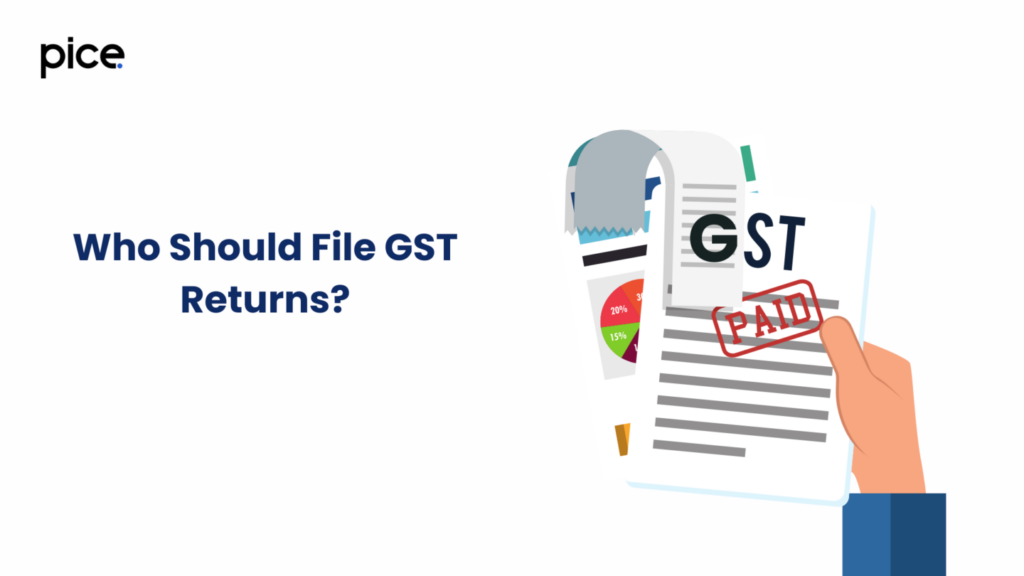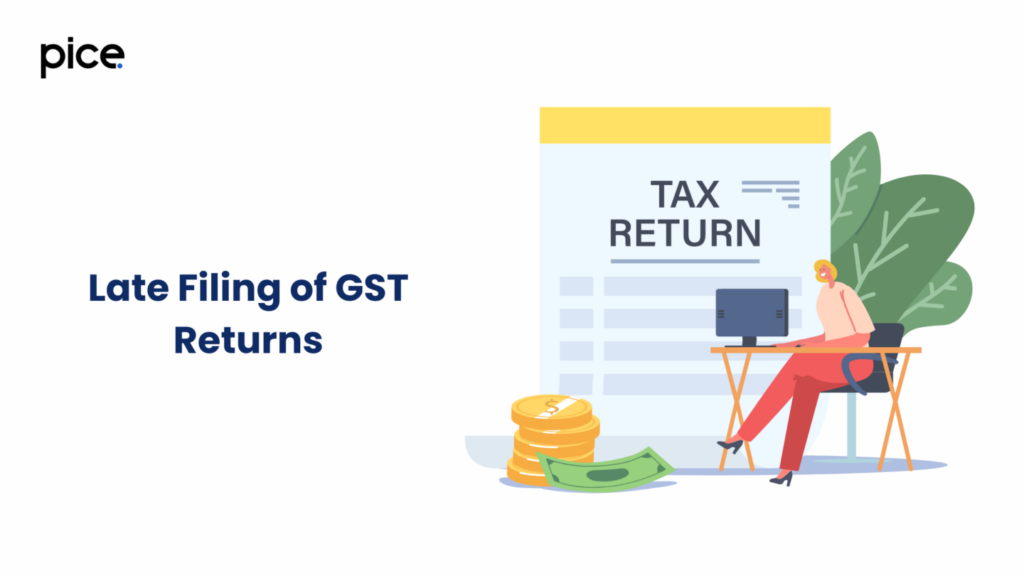GST Return: What Is GST Return, Who Should File, Due Dates & Types of GST Returns
- 29 Aug 24
- 16 mins

GST Return: What Is GST Return, Who Should File, Due Dates & Types of GST Returns
Key Takeaways
- Mandatory Filing: All GST-registered taxpayers must file GST returns, detailing sales, income, expenses, and purchases.
- Types of Returns: Various GST returns include GSTR-1 for outward supplies, GSTR-3B for summary returns, GSTR-4 for composition scheme returns, and GSTR-9 for annual returns.
- Filing Frequency: Non-QRMP filers (annual turnover > ₹5 crore) file 25 returns annually, while QRMP filers (turnover up to ₹5 crore) file 9 returns annually
- .Penalties for Late Filing: Missing GST return deadlines can result in a late fee of ₹200 per day, capped at ₹5,000 per Act, and interest at 18% per annum on outstanding taxes.
- Online Filing via GSTN: GST returns can be filed online using the GST Network (GSTN) by uploading invoices, receiving unique reference numbers, and submitting forms GSTR-1 and GSTR-2.
The GST returns is a mandatory form that every taxpayer registered under GST needs to file. It has been observed that the collection of GST in March 2024 increased by 11.50% and stood at ₹1.78 lakh crore due to the mandate of filing GST returns. However, to streamline the process, the government has introduced various types of GST returns for different taxpayers. If you are a GST-registered taxpayer, looking to file returns under GST, read on to learn about types of GST returns in detail.
What Is a GST Return?
GST returns refer to the form that contains comprehensive financial details of the taxpayers. These details include sales, income, expenses and purchases the taxpayer conducts during a particular financial year.
The assessee has complete flexibility to file these transactions either monthly or quarterly. When filing, all they will need to do is enter information involving purchases, sales, Input Tax Credit (GST paid on purchases), Output GST (on sales) and so on.
Who Should File GST Returns?

All individuals and businesses who have registered themselves under the GST regulation have a mandatory binding of filing GST returns. However, the frequency of filing varies with different GST-registered entities.
The taxpayers registered under GST can be classified based on the Quarterly Return Filing and Monthly Payment of Taxes (QRMP) Scheme. The classification is as follows:
- Non-QRMP Filers
Companies having annual aggregate turnover of more than ₹5 crore and the ones that are not eligible under the QRMP scheme will have to file 25 returns in a year. This includes two monthly returns and one annual return.
- QRMP Filers
If a business has an annual aggregate turnover of up to ₹5 crore, it will need to file about 9 returns in a year. These filings include four GSTR-3B returns, four GSTR-1 returns and one annual return. However, they will have to pay taxes every month even though they are filing tax returns quarterly.
Apart from these two categories of entities, there are composite dealers as well who will have to file 5 GST returns each year. These returns include 1 annual return GSTR-4 and 4 statement-cum-challans in CMP-08.
Types of GST Returns
GST returns can be classified into various types based on the type of business, type of taxpayer and other factors. The following are different types of GST returns available to taxpayers need to file under different circumstances:
- GSTR-1 (Outward Supplies Return)
All normal taxpayers, registered under GST, need to file GSTR-1 to report the supplies and returns of the goods made. This form type has all the debit-credit notes and invoices involved in transactions during a particular time period.
Furthermore, taxpayers can also make necessary amendments in the sales invoices belonging to the previous tax periods when filing GSTR-1. You can file this GST return type on a monthly as well as quarterly basis.
- GSTR-2A (Dynamic View-Only Return)
This is a type of view-only GST return that goods and service buyers can file. This return type contains all the purchase details that they have made from a GST-registered entity during a specific tax period.
In most scenarios, the data is auto-filled in GSTR-2A, based on the inputs provided by the GST-registered suppliers. Even, the data from the Invoice Furnishing Facility (IFF) furnished by the QRMP gets automatically inputted. This auto-filing facility minimises the chances of errors, increasing the efficiency of tax filing.
The only drawback associated with this type of GST return is that this is a read-only document. So, you cannot make amendments in case of errors or missing documents. Hence, you will have to go back to the GSTR-1 form to make the changes. Usually, you will need to file GSTR-2A every month for the first two months of the quarter.
- GSTR-2B (Static View-Only Return)
Similar to GSTR-2A, the GSTR-2B is also a static read-only document that is important for buyers or recipients of goods and services. This form contains all the updated Input Tax Credit (ITC), whenever you check it.
As a taxpayer, you can get various crucial insights regarding the actions to be taken in case of reversing the invoice reported, marking it ineligible, and so on. However, you will need to file this GST return type every month, to enjoy the benefits associated.
- GSTR-2 (Suspended Return)
This GSTR type is available to buyers registered under GST, to report various purchases that they have made during a given tax period. Every nominal taxpayer under GST needs to file a GSTR-2. Nonetheless, the filings of this form have been suspended since September 2017.
Usually, the details are auto-filled in this document, from the GSTR-2A form. However, one of the striking differences between GSTR-2 from GSTR-2A is that the former is editable but the latter is not.
- GSTR-3 (Suspended Return)
This is another return that taxpayers need to file to summarise their outward and inward taxable supplies. Also, it contained details of input tax credits claimed, taxes paid and the tax liabilities incurred.
Usually, this document was auto-generated using the information available in GSTR-1 and GSTR-2. However, since September 2017, the filing of GSTR-3 has been suspended, similar to GSTR-2.
- GSTR-3B (Summary Return)
The GSTR-3B is a mandatory self-declaration document that all taxpayers need to file. It primarily contains details such as input tax credits claimed, outward and inward supply details, tax payable, tax liabilities incurred and so on.
However, before filing GSTR-3B, it is essential for a taxpayer to reconcile the details with GSTR-1 and GSTR-2B. Doing so ensures that there are no further mismatches in data, leading to notices or the suspension of GST registration.
- GSTR-4 (Composition Scheme Return)
This is the annual return that is mandatory for all taxpayers to file before 30th April for the concerned financial year. Prior to the introduction of GSTR-4, taxpayers had to file GSTR-9A as an annual return under the GST, and that to every quarter.
- GSTR-5 (Non-Resident Foreign Taxpayer Return)
This is a return type that non-resident taxpayers have to file when carrying out business activities and associated transactions in India. The document contains all the crucial details such as credit/debit notes, inward and outward supplies, taxes paid, tax liabilities, and so on.
- GSTR-5A (OIDAR Services Return)
This is a type of summary return used for filing the tax supplies and tax payables by Online Information and Database Access or Retrieval Services (OIDAR). However, it is essential to file this return type by the 20th of every month.
- GSTR-6 (Input Service Distributor Return)
This is a type of GST return that an Input Service Distributor (ISD) needs to file every month. It contains all the necessary information regarding ITC that the ISD receives and distributes. Furthermore, this document also contains all the necessary details regarding the distribution of input credit and the manner of distribution.
- GSTR-7 (TDS Return)
If you are eligible for TDS under GST, you will need to file GSTR-7 returns every month. It contains essential details associated with TDS such as TDS liability payable and paid, TDS deducted, TDS refund claimed and so on.
- GSTR-8 (E-commerce Operator Return)
Primarily, the e-commerce operators who are registered under GST have to file this type of GSTR. They usually collect Tax at Source (TCS) which makes it crucial for them to file GSTR-8 returns by the 10th of every month. This document mentions all the details related to the goods supplied through the e-commerce platform.
- GSTR-9 (Annual Return):
All taxpayers registered under GST need to file the GSTR-9 as the annual GST return statement. However, there are some exception groups to filing the GSTR-9 form such as casual taxpayers, assessee under the composition scheme, and so on.
It contains all the essential details regarding inward supplies received, outward supplies made, taxes paid under different heads, and so on for a particular financial year. The GSTR-9 form acts as a consolidation for all quarterly and monthly returns filed in a year.
- GSTR-9C (Reconciliation Statement)
This is a type of self-certified reconciliation statement between the GSTR-9 and the books of accounts. Every GST-registered person with an annual turnover of more than Rs. 5 crore needs to file GSTR-9C. Usually, one PAN can have multiple GSTR-9C filed under it.
- GSTR-10 (Final Return):
The GSTR-9C is a form that a GST-registered person can file who got their registration surrendered or cancelled. This return type is also known as the final return, and it needs to be filed under a specific due date.
- GSTR-11 (UIN Holder Return)
Persons with a Unique Identity Number (UIN) can file this return type to claim a refund on their GST. This facility is usually available for the goods and services that have been purchased in India. The GSTR-11 form contains all the details of refunds claimed and the inward supplies received.
Due Dates for Various Types of GST Returns
You should note that each of these types of GST returns is associated with a due date for filing them. Beyond this date, returns filing can cost you additional penalties. Hence, you should file the GST mandatorily before this date.
Here are the due dates for different types of returns under GST:
- GSTR-1: All regular taxpayers must file this by the 10th of the next month and the 13th of the month after the end of a quarter.
- GSTR-2A: This type of return is auto-generated for all types of taxpayers, and is mainly used for reconciliation.
- GSTR-3B: Normal taxpayers must file this GST return type by the 20th of the following month or between the 22nd and 24th of the month after the quarter ends.
- GSTR-4: This type of GST return is applicable for Composition dealers, and needs to be filed by the 30th of the month succeeding the financial year.
- GSTR-5: A non-resident taxable person needs to file this return type by the 13th of the following month.
- GSTR-6: You need to file GSTR-6 by the 13th of the next month.
- GSTR-7: TDS deductors have to file the GSTR-7 form by the 10th of the following month.
- GSTR-8: All e-commerce operators need to file the GSTR-8 by the 10th of the next month.
- GSTR-9: This is the annual return that regular taxpayers need to file by 31st December of the next financial year.
- GSTR-9C: All regular taxpayers need to file GSTR-9C annually, by the 31st December of the next financial year.
- GSTR-10: If a taxpayer’s GST filing gets cancelled, they will need to file GSTR-10 within 3 months of the cancellation.
- GSTR-11: A person having UIN and claiming a refund needs to file GSTR-11 within the 28th of the following month.
Late Filing of GST Returns

As a GST-registered taxpayer, you should note that it is a must to file GST returns on time. Otherwise, tax authorities can levy late fees as well as take other severe steps. Listed below are some crucial norms associated with late filing of GST:
- Mandatory Return Filing
All taxpayers must file their GST return every month or quarter as applicable. Even when you do not conduct any business transactions, you will have to file NIL returns during that period to avoid complications.
- Cascading Effect of Late Filing
You must note that if you miss out on filing the previous month’s or previous quarter’s GST returns, it can lead to a cascading effect. Thus, you will not get to file it in the current month, leading to a backlog of pending returns.
- Late Filing Fee
You will need to pay heavy fines and penalties such as a late filing fee, for delaying the filing of GST returns. Every delay in the filing of GSTR-1 appears in the liability ledger of the GSTR-3B form, leading to penalties.
- Interest on Outstanding Tax
In addition to the late payment penalty, the taxpayer will also be compelled to pay interest at a rate of 18% per year. This interest is usually calculated by taking the amount of outstanding tax into account. The calculation starts from the day after the due date to the day on the date of the payment made.
- Late Fee Charges
As per CGST and SGST Acts, the late fee for delay in GST returns filing is ₹100 per day per Act. So, you will have to pay ₹200 per day for the delay. However, the maximum limit for this late payment is ₹5,000 per act.
- Late Fees for GSTR-9/9C
The State or Union Territory has capped GSTR-9 and GSTR-9C, late fees at 0.25% of the turnover. However, you must note that this amount is subject to variation as and when the government decides.
How to Check GST Returns Status?
Checking the GST returns status is essential to ensure that you do not miss out on the due dates, which can at times lead to the payment of fines. Following are the 3 ways in which you can check the GST returns online:
- Tracking the Status Using the ‘Return Filing Period' Option
You can instantly check the status of your GST returns filing using the ‘Return Filing Period’ option by following the steps below:
Step 1: Move to the official website of GST.
Step 2: Log in to the portal using your credentials.
Step 3: Navigate to the ‘Services’ tab.
Step 4: Click on the ‘Returns’ button from available options.
Step 5: Choose the ‘Track Return Status’ from the list present.
Step 6: Select the ‘Return filing period’ option.
Step 7: Input the necessary data as applicable.
Step 8: Once done, click on the ‘Search’ button.
As soon as you do so, the GST returns status filed on the date entered will appear on your screen.
- Tracking the Status Using the ‘ARN' Option
If you have the unique, 15-digit, Application Reference Number (ARN) of your GST returns application, you can use it as well to track its status. The steps for tracking status using ARN are as follows:
Step 1: Navigate to the official portal of GST.
Step 2: Enter your credentials to log in to the portal.
Step 3: Download the GST return document in PDF format to access the ARN.
Step 4: Move to the ‘Return’ section present under the ‘Services’ tab.
Step 5: A drop-down list appears from where you need to click on the ‘Track Return Status’ button.
Step 6: Select ‘ARN’ from the available options.
Step 7: Accurately type the ARN in the space provided and click on the ‘Search’ button.
Once done, the status of your GST returns appears on your device’s screen.
- Tracking the Status Using the ‘Status' Option
To simplify the task of tracking GST returns, you can use its status to search for them. The steps for this are as follows:
Step 1: Navigate to the GST portal and log in using your credentials.
Step 2: Move to the ‘Services’ tab available on the home page.
Step 3: From the available options, click on the ‘Returns’ tab.
Step 4: A drop-down list appears, from where you need to select ‘Track Returns Status’.
Step 5: Three options appear on your screen, from where you need to click on ‘Status’.
Step 6: Choose the return status of GST that you are looking for.
Step 7: Lastly, click on ‘Search’ to see all the GST returns with the status that you have selected.
Once done, the GST returns with the chosen return status will appear on your screen.
How to File GST Returns with GSTN?
Online GST filing has now been simplified due to the availability of the Goods and Services Tax Network. You will need to follow the steps mentioned below to complete the entire process using GSTN:
Step 1: Visit the official GST website.
Step 2: Enter your PAN and state code.
Step 3: After data verification, you will get a 15-digit GSTIN.
Step 4: Upload all the invoices that you have on the portal. After that, you will receive a unique invoice reference number.
Step 5: File your returns.
Step 6: File details of supplies made and associated returns in the GSTR-1 form.
Step 7: Submit the details of inward supplies of taxable goods and services in the GSTR-2 form.
Conclusion
Once you have a thorough idea of the types of GST returns and the due dates for filing them, make sure to avoid missing out on them. Otherwise, you will not only have to pay hefty returns but also might encounter other severe consequences. For ease, you can set a reminder, ensuring that you never miss filing your GST returns for your venture on time.
💡 If you want to pay your GST with Credit Card, then download Pice Business Payment App. Pice is the one stop app for paying all your business expenses.
 By
By 















